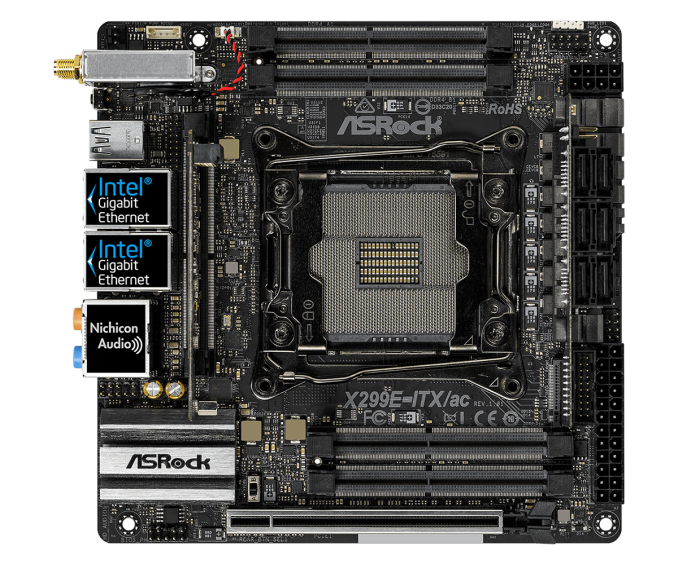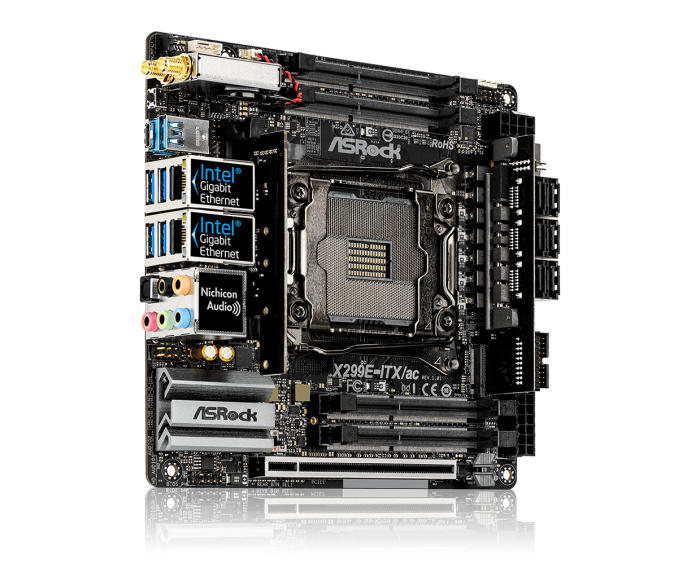The ASRock X299E-ITX/ac Motherboard Review: An 18-core No-Compromise Mini-ITX
by Joe Shields on December 4, 2017 8:00 AM ESTConclusion
The ASRock X299E-ITX/ac is priced at $399 on Newegg and lands it towards the higher end of all X299 motherboards. If we look at only the Mini-ITX space, it is in a class of it its own because it is the only ITX size board currently out for X299. It also marks the most expensive mini-ITX motherboard ever launched to consumers.
The niche this falls into is a small form factor, high horsepower, single GPU system. There are MicroATX boards available which fits the 'smaller than ATX bill', however, outside of Kaby Lake-X support and physical full-length PCIe slot count for SLI/Crossfire capabilities, the features sets between them all are quite similar with the ASRock board having the advantage of more M.2 slots and Wi-Fi compared with the micro-ATX competition. The X299E-ITX/ac requires SO-DIMM memory modules as opposed to the MicroATX boards which use full-size DRAM modules, but a quick look at pricing doesn't show too much difference.
In many cases, the small size and full-featured nature of the board gave way to a lack of aesthetic additions. For all intents and purposes, a Mini-ITX board is intended to be more functional than easy on the eyes on the first place.
To that end, the ASRock X299E-ITX brings almost everything one needs in a PC. We can argue that it might be missing some features seen on other $400 X299 boards, perhaps such as 10 GbE, U.2 support or the ability to use 128GB of RAM, but frankly, if those are build requirements, users are likely looking to a larger board in the first place.
Although Kaby Lake-X support is not found on this board, full support is provided up the stack for Skylake-X CPUs, including the Core i9-7980XE with 18 cores, 36 threads, and 165W TDP. In order to support the latest HEDT CPUs, the board requires a decent VRM and ASRock has provided just that. The parts used are fairly reasonable, with a 7-phase solution with DrMOS integrated power stages, which handled what we threw at it. That isn't to say it couldn't be improved, at least the heatsink side, which was certainly warmer than other boards that we have tested, but the system didn't fault even in our overclocks. Not only is the VRM heatsink small, but the daughterboard for SATA/USB is located directly on top of it. We are again getting out of what most would consider to be 'normal' use of such a board too.
Overclocking with the board and heatsink really wasn't an issue as we did not see throttling throughout testing. Through the hour plus of scripted testing, the heatsink was warm/hot to the touch, warmer than others by feel, but nothing alarming. Pushing things to 4.5 GHz our CPU cooling limit and running stress tests did manage to get it hot. This on an open test bench, which might be a more favorable scenario, although we did not apply any significant airflow over the situation. Stuffing this inside a SFF case and trying to overclock would more than likely lead to higher temperatures on the VRM and potential throttling. Good internal airflow or spot cooling is recommended if users are to really keen on this board in a small case with an overclock.
New to this review are the SO-DIMM memory sticks used. GSkill sent us 4x8 GB DDR4-3800 sticks which the board handled without issue by simply enabling the XMP profile.
Overall, there isn't much to complain about, at least without considering the size of the board in the first place. For the vast majority of users looking for a Mini-ITX size board, it has most of features found on the X299 based motherboards. We can nitpick about some features being missing, but given the size it is difficult to hold it against this board. An option that might be worth examining for the future might be partitioning the audio to a separate riser card.
The ASRock X299E-ITX/ac is, at the moment, a one of a kind motherboard for X299 in the Mini-ITX form factor. We are not sure if others will be coming out with some later, but if users require Skylake-X CPUs in an ITX format, this is the only choice. It does come at a price premium, at almost $400, but for a motherboard less than half the size of ATX it has nearly all the features of larger motherboards, and in some cases even more, and is able to command such a premium.
The Recommended by AnandTech Award
The ASRock X299E-ITX/ac
Mini Yet Mighty: A New Standard for 18-Core Small Form Factor Motherboards













24 Comments
View All Comments
mkaibear - Monday, December 4, 2017 - link
In before lolicabbage makes his "just buy threadripper, you never need to buy x299x comments....which would be especially funny on this article, obviously...
Hendrix2112 - Monday, December 4, 2017 - link
Am I the only one who is amazed by what the engineers who designed this did? Fitting 4 channels of ram, 3 M.2 slots, VRM to handle a *cough* 165w processor, and all the other features, is really awesome.Even though I have no interest in using this board, although I would consider it if I was going to use x299, I love seeing the limits pushed of what can currently be done with motherboard.
Good job Asrock!
Vatharian - Monday, December 4, 2017 - link
ASRock's engineers were always on the edge. They are like 'hold my beer' of an IT. Anyone remember H67 board that took Westmere CPUs, despite Intel saying 'It's NOT possible in any way?', or P4 combo, or KxN upgrade with additional S939/AM2/AM2+ expansion boards? Or general notion of having PCI-Express, and AGP on one board? Or general any arcane tomfoolery they are constantly pulling off? Every time they out something like that, I'm amazed. Need storage without dipping in Xeons? Got you covered, X99-Extreme11 with no less than 18 SATA ports. Only thing they have been beaten in so far was a board that decks out full PCIe x16 slots coverage, either ASUS with one of their WS boards or MSI with Big Bang Fusion 9 did it first, I believe.On a related note, where is review of any X399 board?
jordanclock - Monday, December 4, 2017 - link
I had an ASRock board that had both PCI-Express and AGP as well as DDR2 and DDR memory. I think it was the 4CoreDual-SATA2. It was great for someone that could only afford one upgrade at a time over a few months.mapesdhs - Thursday, December 7, 2017 - link
I've got one of those somewhere. :D Also have a board which has the AM2 upgrade option, kinda cool.vgray35@hotmail.com - Monday, December 4, 2017 - link
I wholeheartedly agree with that sentiment - a totally amazing accomplishment, and I might add for several years now I look forward to what they will come up with next. It is not long now before ASROCK implements hybrid PWM-resonant switching and resonance scaling to build VRMs with >98% efficiency (no heat sinks), where inductors are replaced by a 5mm length of copper wire. Believe it or not the X399 Threadripper will fit on a mini iTX board (expensive though).http://www.powerelectronics.com/sites/powerelectro...
Gadgety - Monday, December 4, 2017 - link
I agree, ASRock makes great boards and stretch the envelope.The_Assimilator - Monday, December 4, 2017 - link
Nope, this board is all around a very impressive piece of engineering, and massive and well-deserved kudos go to those who designed and built it. Oh, and then they added overclocking capabilities too.My only complaint is the use of SODIMMs - while that's a necessary compromise to get quad-channel on a board this tiny, it does mean that if you have existing memory you have to replace it, and any memory you do buy for this board you probably won't be able to reuse in any future builds. If I'd been designing this board, I'd probably have tried to go for 4x full-size DIMM slots on the rear of the motherboard (which would necessitate ditching the pair of M.2 slots, but oh well).
I'm still waiting for the first motherboard manufacturer that puts the power and SATA connectors on wires/ribbon cables from the rear of the board, which would open up a massive amount of real estate on the front side (not to mention help with cable routing).
edzieba - Monday, December 4, 2017 - link
Rear DIMM slots would also make it incompatible with every ITX (or ATX) case on the market: there is insufficient clearance beneath the motherboard for a DIMM, even lying that with no cosmetic 'heatsink'.The_Assimilator - Tuesday, December 5, 2017 - link
Not an issue if you right-angle the DIMM slots so that they're parallel to the motherboard instead of perpendicular - in the same way that notebooks do.